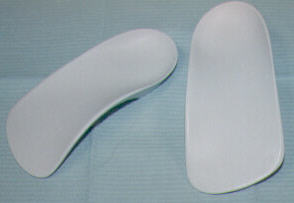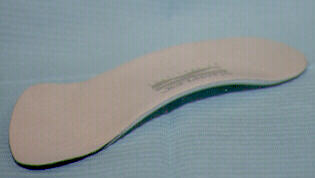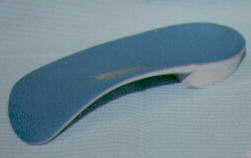Ground Floor, 603 7th avenue, S.W. Calgary, Alberta, Canada T2P 2T5 (403) 266-2700
Adapted for the aus.bushwalking FAQ with full acknowledgement to the Clinic.
Send any comments to the maintainer Roger Caffin
Please note that the aus.bushwalking web site has no medical qualifications and cannot accept any responsibility for any medical advice given. This information is provided for general information only on an "as is" basis.

Podiatrists prescribe and construct foot orthotics. These are specially designed devices that are worn inside the shoe to control abnormal foot function and/or accommodate painful areas of the foot. Properly designed foot orthotics may compensate for impaired foot function, by controlling abnormal motion across the joints of the foot. This may result in result in dramatic improvement in foot symptoms. Functional foot orthotics are usually made from rigid materials, especially plastics and carbon-fiber composites. They are constructed upon a plaster impression of the feet, and modified based on the podiatrist's evaluation of your problem. They are normally quite comfortable, and do not feel hard or uncomfortable in the shoe. Rigid orthotics normally last for years, additions such as top covers and extensions may require periodic replacement. Some patients, for example the very elderly, may not tolerate rigid functional orthotics. Under these circumstances, the podiatrist will prescribe an orthotic made from softer materials with special accommodations for painful areas. Many different materials can be utilized, such as rubber, cork, leather, and soft synthetic plastics. The podiatrist is in the unique position of being able to evaluate, diagnose, and treat your foot or leg problems. If orthotics are indicated, he or she can utilize the most advanced methods of construction. Orthotics that are prescribed by the podiatrist and custom made for your feet, should not be confused with over the counter arch supports. These may help the occasional patient with minor arch discomfort, but they frequently fail because they do not properly control foot function and/or do not properly fit the patient's feet. The consumer should beware of individuals with no or inadequate training, who hold themselves out as experts on foot problems and orthotics. Only the podiatrist, chiropodist, or medical doctor can diagnose foot problems and offer alternative treatment plans. If complications develop, the podiatrist is there to evaluate and treat those. He or she can offer the patient alternative treatments, be they medical, orthopedic, or surgical.

Unlike simple arch supports, functional posed orthotics control abnormal position and movement of the foot. While standing or walking the heel and midfoot are held in a more stable position. This allows the foot to function more efficiently during weight-bearing and propulsion. This control is often accomplished by limiting abnormal pronation of the foot. Pronation is a complex movement involving eversion (turning out) of the heel and forefoot. There is a corresponding internal rotation (turning in) of the lower leg, and flattening of the arch. Ligaments become strained, and muscles over work attempting to pull the foot into a more stable position. By controlling abnormal pronation, functional orthotics help prevent some of the complications of the chronically unstable foot. Functional orthotics are usually (but not always) made from rigid plastic materials. There may be various additions, top covers, and extensions, depending on the patient's need. They are very comfortable, as they are custom made from plaster impressions. The posts on a functional orthotic are wedges at the heel and midfoot, which hold those structures in a proper angular relationship to each other and the leg. Functional posted orthotics should only be prescribed by a properly trained practitioner after a through biomechanical examination.
Orthotics will control the position and motion of your foot. This may prevent the development of pain and disability, and the development of additional deformity. Orthotics will not change the underlying structure of the adult foot. If they are not worn, abnormal function will immediately return. In a sense they are analagous to dentures, if you remove then you can no longer properly chew your food.

The short answer is no. Some shoes will not fit properly with an orthotic inside. These are usually dressy shoes with a shallow heel counter (i.e the rear part of the shoe that wraps around the heel). Women have more fitting problems than men, due to shoe fashion. You can find dress shoe that nicely fit an orthotic, but choices will be more limited. There are special dress shoe orthotics that fit more easily into fashionable shoes. Discuss with your podiatrist if these are suitable for you.
Some people develop discomfort in the foot, leg, or lower back when they first start to wear orthotics. This is normal and is due to a realignment of the whole lower extremity and pelvis. Muscles and ligaments have to readjust to this new alignment. When they do the discomfort disappears. Most patients never have any "break in" discomfort. When it occurs, it usually disappears in a two or three weeks. If the discomfort occurs, it is advisable to gradually "break in" your new orthotics. Persistent discomfort may necessitate adjustment to your orthotics.

For more information check the original URL: http://www.foottalk.com/faqorth.htm
Thanks to Kathy and Steve Kilpatrick for URL